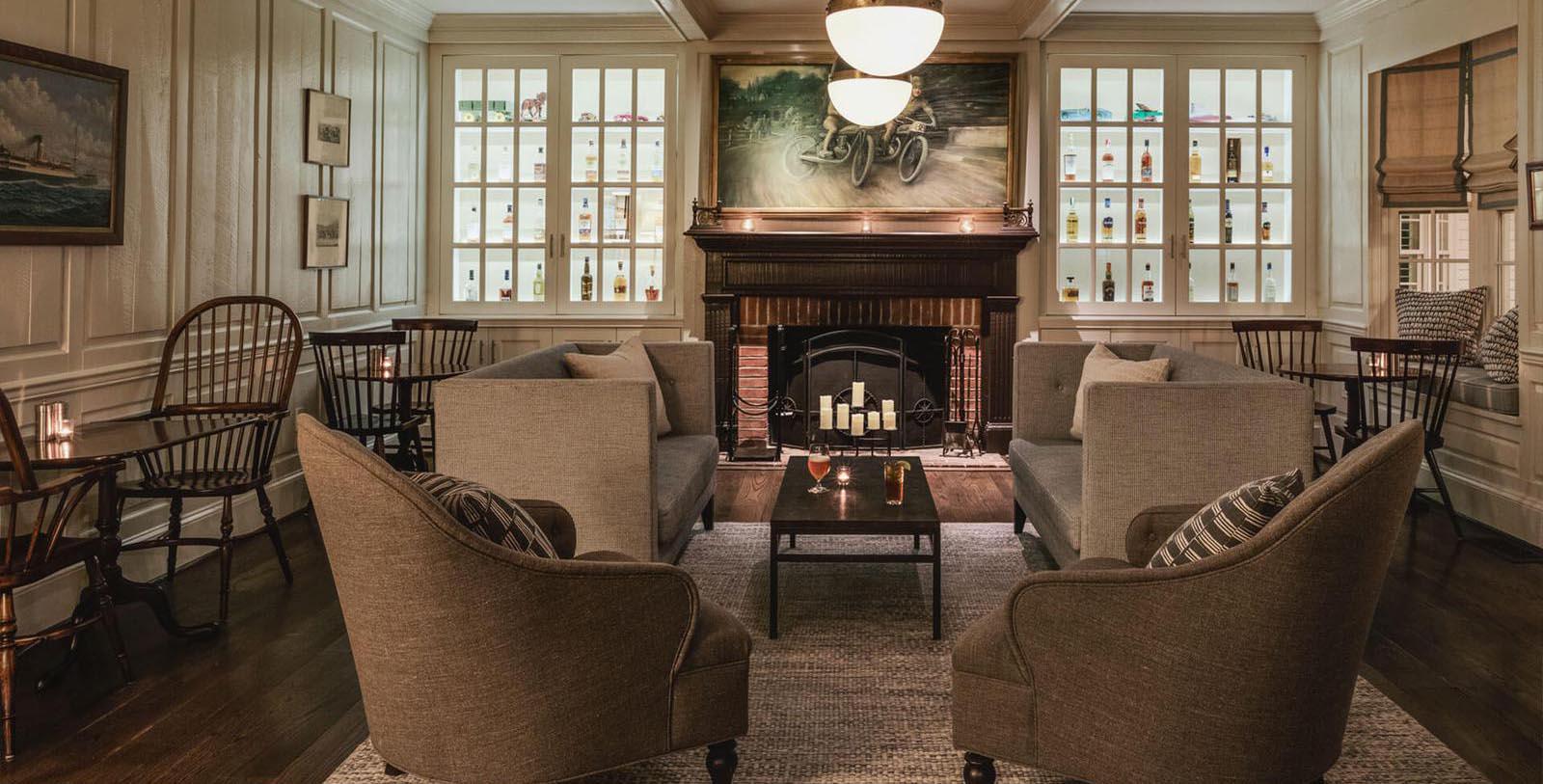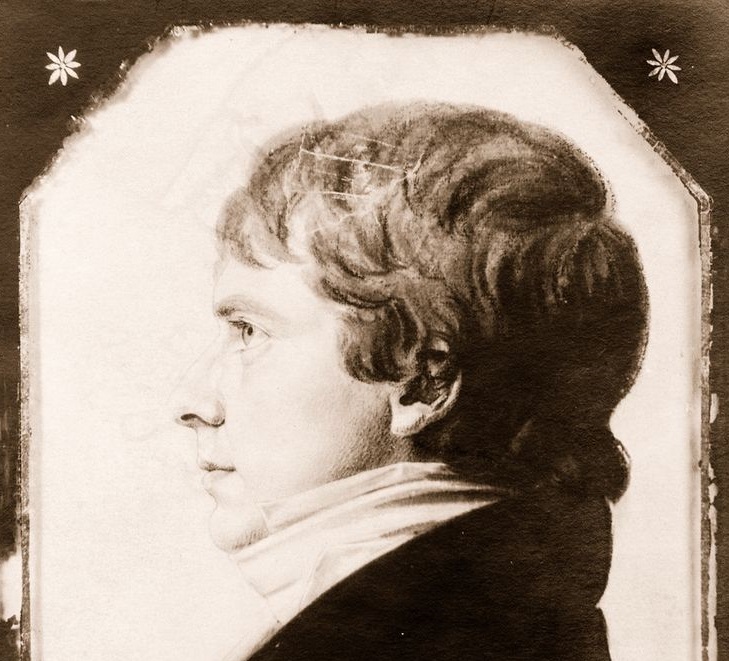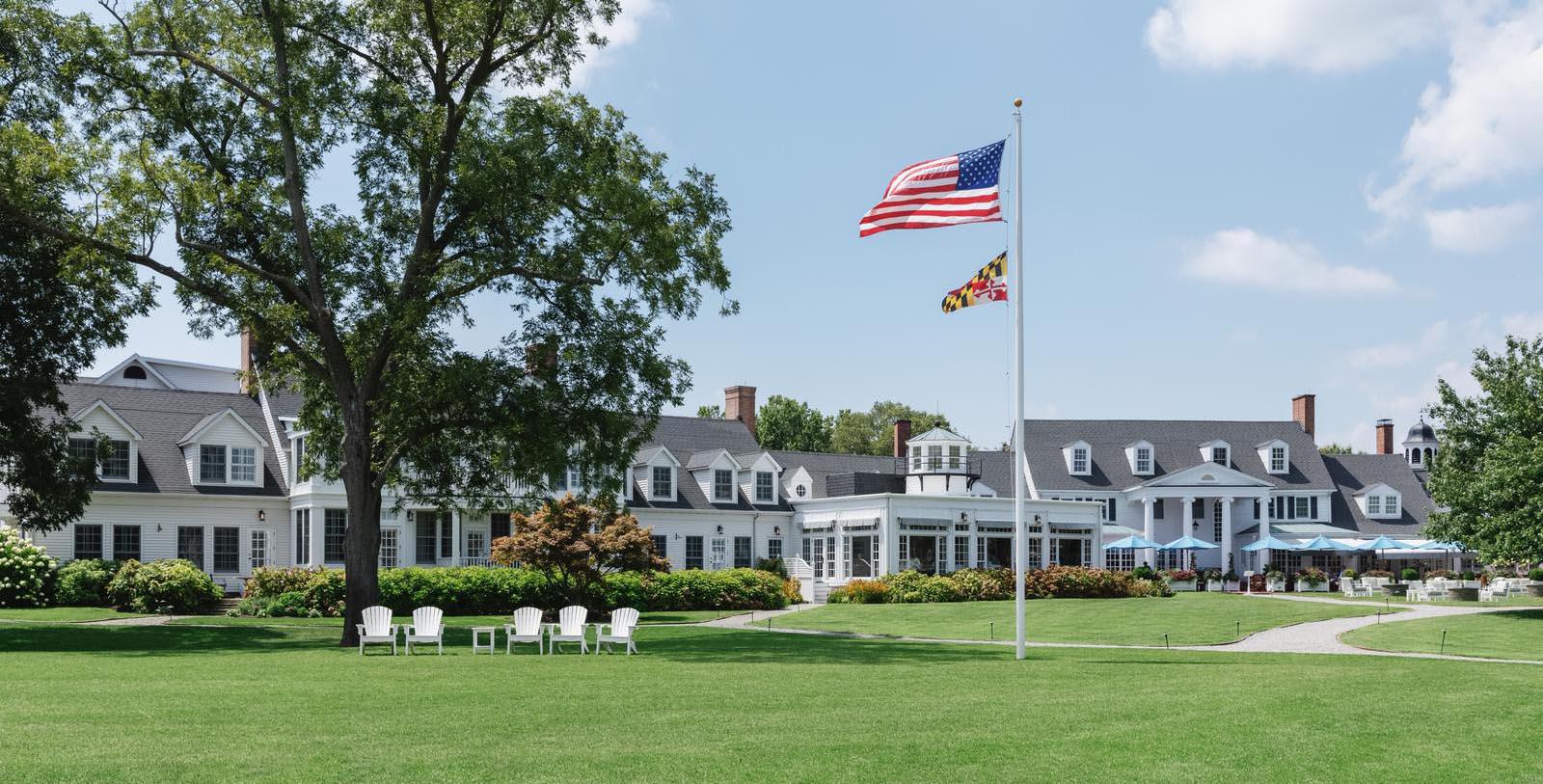Receive for Free - Discover & Explore eNewsletter monthly with advance notice of special offers, packages, and insider savings from 10% - 30% off Best Available Rates at selected hotels.
history
Discover the Inn at Perry Cabin with its distinctive nautical design, built to resemble Commodore Oliver Hazard Perry's cabin on flagship U.S.S. Niagara.
Inn at Perry Cabin, a member of Historic Hotels of America since 2018, dates back to 1816.
VIEW TIMELINELocated on 26 acres of forest and farmland, the charming Inn at Perry Cabin enchants its visitors with stunning waterside views of the beautiful Miles River. Perhaps its wonderful scenic topography was the reason why Samuel Hambleton first constructed this spectacular facility more than three centuries ago. Hambleton had made a name for himself by serving as aide-de-camp to Commodore Oliver Hazard Perry during the War of 1812. The naval officer specifically provided much needed consul to Commodore Perry, as he attempted to prevent the British from completely seizing the Great Lakes. The climax of their efforts occurred 1813, when Perry and his staff decided to fully drive the British from the area—specifically Lake Erie. With practically no support from the federal government, Perry, Hambleton, and the other U.S. naval officers onsite oversaw the creation of nine small warships as well as the training of their respective crews. Taking all summer to prepare, Perry and his men sailed to engage the British squadron led by Captain Robert Heriot Barclay that September. In what became known as the “Battle of Lake Erie,” Perry’s fleet subsequently captured the entire British command in short order. But the fight was not without its tribulations, as Perry’s flagship—the U.S.S. Lawrence—was sunk by an enemy salvo. In one memorable moment, Perry, Hambleton, and the other survivors boarded a lifeboat and rowed toward the nearby U.S.S. Niagara. Making the ship the new command post, Perry and Hambleton sailed the U.S.S. Niagara right into the heart of the British flotilla to force its surrender.
The battle proved to be a great strategic victory of the United States, enabling its armed forces to recapture Fort Detroit and break apart the Native American coalition that had recently allied with the British. More importantly, it gave the American public a significant boost in morale, especially since the war had not gone as smoothly as planned. When the War of 1812 finally ended some two years later, Congress awarded Hambleton with a small land grant in his native state of Maryland. He requested that the grant allow for him to construct a new home in St. Michaels, where he had grown up as a child. Soon enough, Hambleton had developed a tobacco farm of nearly two dozen acres that he called, “Navy Point.” At its center was a stunning Greek Revival-style manor that he had named “Perry Cabin” after his longtime friend, Oliver Hazard Perry. In fact, most of the building’s interior spaces resembled the living quarters that the commodore inhabited onboard his second flagship, the U.S.S. Niagara. Despite the estate’s alluring tranquility, Hambleton seemingly occupied the estate sporadically throughout the remainder of his life. This was due to the fact that he remained incredibly active within the United States Navy, helping to command such ships that frequently sailed across the Caribbean and Mediterranean seas. Hambleton even saw a three-year tour as a supervisor of the famed Philadelphia Navy Yard during the mid-1840s.
Upon Hambleton’s death in 1851, the entire estate continued to serve as a farm for nearly a hundred years. Then, in 1952, a group of new owners decided to transform the location into a prominent riding academy. Its transformation into exposed it to a wealth of new people in the equine racing community, including the prestigious Harry and Teresa Meyerhoff. Prestigious horse breeders, the two were the owners of 1979 Kentucky Derby winner, Spectacular Bid. They soon learned of Perry Cabin and immediately fell in love with both the facility and surrounding area. Thus, in 1980, the Meyerhoffs decided to buy the riding academy, in order to renovate it into a small holiday destination called the “Inn at Perry Cabin.” Initially numbering just six rooms, it quickly grew in size once Sir Bernard Ashley acquired the site nearly a decade later. Under their watch, the Inn at Perry Cabin subsequently evolved into a leading destination resort known the world over. Sir Ashley eventually opted to sell the Inn at Perry Cabin to Orient-Express Hotels in 1999, which further continued to ongoing renovations to the Inn at Perry Cabin. It has since attracted the likes of important dignitaries and Hollywood luminaries ever since. The resort has won numerous awards for its spectacular services, with glowing appraisals appearing in Condé Nast Traveler and Travel + Leisure. It even served as one of the main backdrops for the 2005 romantic comedy, Wedding Crashers. Now a member of Historic Hotels of America, the Inn at Perry Cabin continues to be among the best historic venues throughout the Mid-Atlantic Region. Guests today are certain to adore its resplendent 19th-century charm!
-
About the Location +
St. Michaels first emerged amid the American Revolution, when British land agent James Braddock established a speculative street grid upon 20 acres he had purchased near the Miles River. Over time, the town became more of a reality, after settlers began constructing dwellings along Braddock’s basic plan. They soon took to calling it “St. Michaels” in honor of an Anglican church that had resided in the region years prior to the town’s founding. Nevertheless, the settlement’s earliest inhabitants were Methodist, giving St. Michaels a unique identity when compared to its neighboring communities. In fact, Braddock himself helped construct the Methodist church at the center of the town square. Even though the surrounding environs of Talbot County entertained a large agricultural economy, St. Michaels itself thrived on commerce generated from the Chesapeake Bay. Shipbuilding was one of the earliest industries to emerge, specifically servicing the fisherman that operated all along the state’s Eastern Shore. As many as six different craftsmen constructed commercial vessels shortly following the founding of the nation, building all sorts of small ships. The most prominent kind was a type of fast schooner that soon came to be known as the “Baltimore Clipper.” The Baltimore Clipper later rose to prominence during the War of 1812, as their speed and size made it easy to avoid British ships prowling the coast. Some Baltimore Clippers even acted as corsairs, harassing British merchant vessels as they attempted to cross the Atlantic. One resident named Thomas L. Haddaway was one such local who engaged in successful pirating raids, launching his own schooner mere days after war had been declared between the two countries.
St. Michaels played a much more prominent role in the War of 1812, when a fleet under the command of Admiral Sir George Cockburn sailed up the Chesapeake Bay. While the admiral’s ultimate objective was the District of Columbia, he struck at various defensive installations throughout the region first. Due to the presence of its vibrant shipyard and local battery of cannons, St. Michaels was among the places Sir Cockburn assaulted. In the early morning hours of August 10, 1813, Admiral Cockburn sent a landing party ashore to wreak havoc. With darkness covering their tracks, the British soldiers engaged a militia company just to the south of town. Scaring away the militia, the marines made short work of the cannons that protected the harbor. They then gave the signal for the main fleet to start bombarding the town. But the ships failed to do any substantial damage to either the town or its shipyard. Many stories abound of why Admiral Cockburn’s men botched their attempt to destroy St. Michaels. The most enduring attest to how its residents ingeniously hung lanterns on high tree branches as a means of confusing the British out at sea. Thinking the town to be further away, most of the sailors missed their shots. As such, St. Michaels earned the moniker as the “town that fooled the British.” By this point of the fight, several other militia units had heard the gunfire and raced their own ordinance to the site. A fierce firefight ensued between the British and the new, makeshift coastal batteries in St. Michaels. Despite being heavily outgunned and outnumbered, the American militia companies managed to turn away the greatest navy afloat at that time!
Shipbuilding had declined significantly by the mid-1800s, but a prosperous oyster fishing industry emerged in its wake. Crabbing and other kinds of commercialized fishing followed suit, too. With the dawn of the next century, every household had at least one person who engaged in some form of commercial fishing for employment. Dozens of boats owned by local fisherman were a common sight in the nearby channel of Eastern Bay. Shucking houses soon defined St. Michaels’ landscape, specifically along the immediate shoreline of the Miles River. One of the most prominent “shucking” businesses of the era was a crabmeat packing company called “Coulbourne and Jewett.” Entrepreneur Frederick Jewett ran the enterprise, becoming one of the first successful African American business owners in Talbot County. He made the firm incredibly prosperous by advertising the crabmeat with a five-level grading system that rated its size and quality. (Consumers had to pick from the following categories: regular, claw, backfin, lump, and special). The system proved so successful that every other crab fisher adopted it—it is even still in use today! In recent years, St. Michaels has emerged as one of Maryland’s exclusive vacation retreats. (The Inn at Perry Cabin has especially driven this development.) But the town is also home to many fascinating cultural attractions, including the Cannonball House, Sherwood Manor, Crooked Intention, and the Saint Michaels Historic District. All are listed on the National Register of Historic Places.
-
About the Architecture +
Greek Revival-style architecture first appeared throughout the western world during the late 18th and early 19th century. It appeared at a time when intellectuals in both Europe and English-speaking North America became obsessed with Greco-Roman culture. The style borrowed heavily from elements of Greek architecture, using it to build a wide variety of civic facilities. Ancient Greek culture was especially popular, for most people knew little about its history. The first archeological excavations had occurred earlier in the 18th century, exposing Hellenistic Greece to the West en mass for the first time. But while many European architects utilized the Greek Revival-style architecture, it truly reached the pinnacle of its popularity in the United States. In fact, some historians consider Greek Revival-style to be the nation’s very first “national” architectural form! The reason for that steeped interest was drawn from romanticized interpretations of Greek society that had started to permeate throughout America. The United States was a young nation at the end of the 1700s, and its citizens were desperate for previous democratic examples that they could emulate in their won republic. Nowhere was this desire more apparent than among the country’s founding elite. They looked to the philosophies of the Grecian republics of antiquity for successful examples of popular government. This pursuit gradually seeped into the cultural fabric of the United States, influencing everything from artwork to literature. Even the names of several towns—including Ithaca, New York, and Athens, Georgia—reflected this development.
The national fascination with ancient Greece took root in America’s architectural practices, too. Many architects began designing buildings that mimicked structures like the great the Parthenon. Even Thomas Jefferson—known to be an accomplished engineer—used Greek design principles to create the Virginia State Capitol Building in 1785. American architects—as well as their European counterparts—typically constructed buildings in the style of Greek Revival by using a symmetrical foundation anchored by combination of stucco and wooden walls. They subsequently painted them white to give the illusion that they had been constructed out of marble or some other elegant stone. A brilliant front portico acted as the main entrance into the building, which was surrounded by a large porch that could span the length of the building’s front façade. The roof itself was low pitched and was either gabled or hipped. Just below the rooftop rested an area called the “entablature” that consisted of elaborate trimming and cornicing. In some cases, the entablature itself consisted of a frieze where most of the decorative work resided. But perhaps the single greatest defining feature of Greek Revival-style buildings were the many columns (or pilasters) that proliferated throughout the interior and exterior. Architects designed the columns in one of three sub-categorical styles known as Doric, Ionic, and Corinthian. They were also usually fluted or smooth and featured an ornate structure called a “capital” at the top. By the 1820s, Greek Revival-style architecture had become the most widely used in the United States. It remained that way for the next three decades, until different revivalist architectural forms finally displaced it in popularity.
-
Film, TV and Media Connections +
The First Kiss (1928)
Wedding Crashers (2005)




































